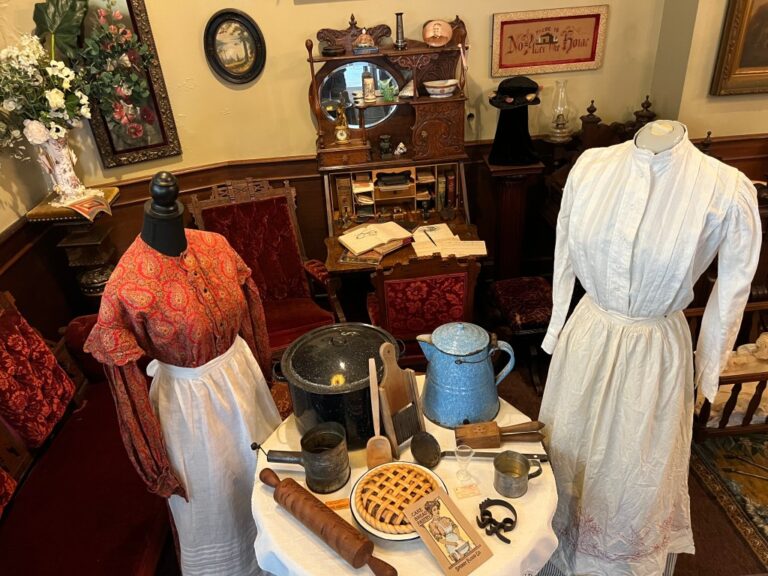The photos are part of the Clark Museum's new kitchen-themed exhibit. The red dress on the left dates from 1890 to 1900. The blouse and skirt combination on the right dates from 1900 to 1910. Also pictured are Victorian-era kitchen utensils. (Heather Shelton/Times-Standard)
The newest exhibit in the Clark Historical Museum's Emerson Room offers a glimpse into what a home kitchen was like in the Victorian era.
“Arsenic and Old Ladies: Victorian Cookbooks” complements the “History of Food and Drink in Humboldt County” exhibit currently on display in the museum's main hall.
“The title of the exhibit was inspired by the play and film 'Old Lace and the Arsenic,'” said Alexandra Cox, curator at the Clark Museum, 240 East Street in Old Town Eureka.

“The exhibit highlights the good and bad innovations in the food industry, including the cookware and food preparation methods used during the Victorian era,” she says. “For example, one part of the exhibit features a table set out with everyday cookware that would have been used in a home kitchen at the time, and two mannequins dressed in simple everyday women's clothing from the period.”
Cox said some of the kitchen items on display are still used by people today, including pots, pans and rolling pins.
“Cooking utensils like the 'universal tool' that was so useful in Victorian kitchens have gone out of fashion,” she says.

There are some pieces in the kitchen-themed exhibit that people might be surprised to see, including several “poison” labels, which Cox said help highlight some of the dangers faced by Victorian diners.
She noted that while the early Victorian diet was healthy in many ways, it could also be dangerous or even deadly depending on where you got your food.


“These (labels) are intended to highlight the fact that in Victorian times, there were instances when toxic ingredients were used in the manufacturing and preparation of food,” Cox said. “This was due to a lack of knowledge about what was safe for human consumption and a lack of regulation of the mass production of food that began during the Industrial Revolution.”
A sign in the exhibit notes that in the early 19th century, nearly all food was still produced locally and was easily accessible to people living in rural areas.
“Early Victorians (1820-1860) had a very nutritious diet that included fresh fruit and vegetables, grass-fed meat and dairy, fish, nuts, seeds and legumes… Much of the food they ate was either grown or produced locally,” the sign reads.
As more people moved from the countryside to cities, transporting and storing food quickly became a problem, and processed foods emerged “which began to have a detrimental effect on public health as early as the late Victorian era (1860-1905),” the sign states.
“The problem was that nothing was as it seemed, as almost every type of food was adulterated in some way,” the sign reads. “From bread, pickled fruit and vegetables to sweets, cakes, cheese and butter, everything was adulterated – that is, foods were enriched with other additives to increase the shopkeepers' profit margins.”

“Some adulterants commonly used in Victorian foods were well known to be toxic at the time, such as lead chromate in mustard, mercury and arsenic compounds in confectionery colourings, and picrotoxin in beer,” the sign reads. “Potatoes, ground bones, plaster of Paris, lime, pipe clay, copper sulphate and alum were all commonly added to bread – all to add weight or whiten it.”
According to the sign, it wasn't until around the 1880s that strict rules were put in place regulating the production and sale of food and beverages for general consumer use.
Clark Historical Museum's exhibit, “Food and Drink of Humboldt County,” will run through August 31. The museum is open Tuesday through Sunday from 10 a.m. to 5 p.m. Admission is $10 per person, with a $30 donation requested for groups of five. For more information about the Clark Museum, visit https://www.clarkemuseum.org or call 707-443-1947.


